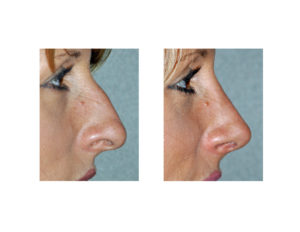Rhinoplasty is not only one of the most frequently performed cosmetic facial procedures but is also the most demanding. Despite the fact that the nose is not altogether that large compared to the overall size of the entire face and skull, its prominence in the center of the face guarantees that even the smallest change will be seen. As few changes caused by rhrinoplastic surgery are reversible, it is of paramount importance that both patient and surgeon are on the same page as to both the surgical goals and what the final outcome could be.
Todays digital cameras, computer uploading, and imaging programs as common as PhotoShop have made it not only possible but very easy and quick to do surgical predictions of the nose. The nose in both profile and frontal views can be done within minutes. While one has to be careful about making computer predictions that can not be done surgically, I have found such imaging to be a both a great communication tool and a fairly estimate of potential outcomes.

As I do an increasing number of ethnic rhinoplasties, of both Asian, Hispanic, and African-American origins, the importance of patient communication and an appreciation of what they want to achieve is of an-ever increasing concern. Most ethnic rhinoplasties, contrary to some beliefs, do not want to be ‘westernized.’ Rather, they seek better proportions of their nasal shape but not a radical change in most cases.
Dr Barry Eppley
Indianapolis, Indiana


